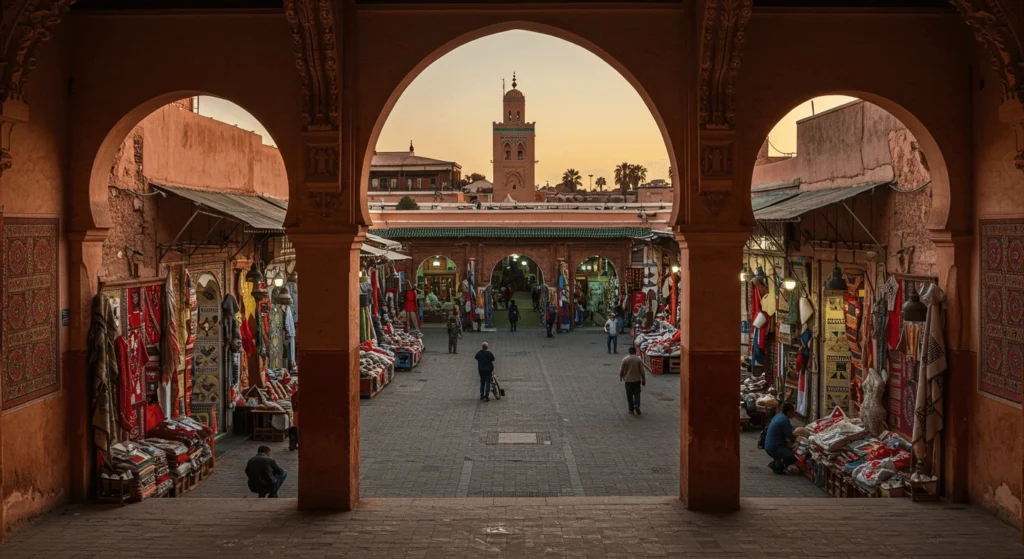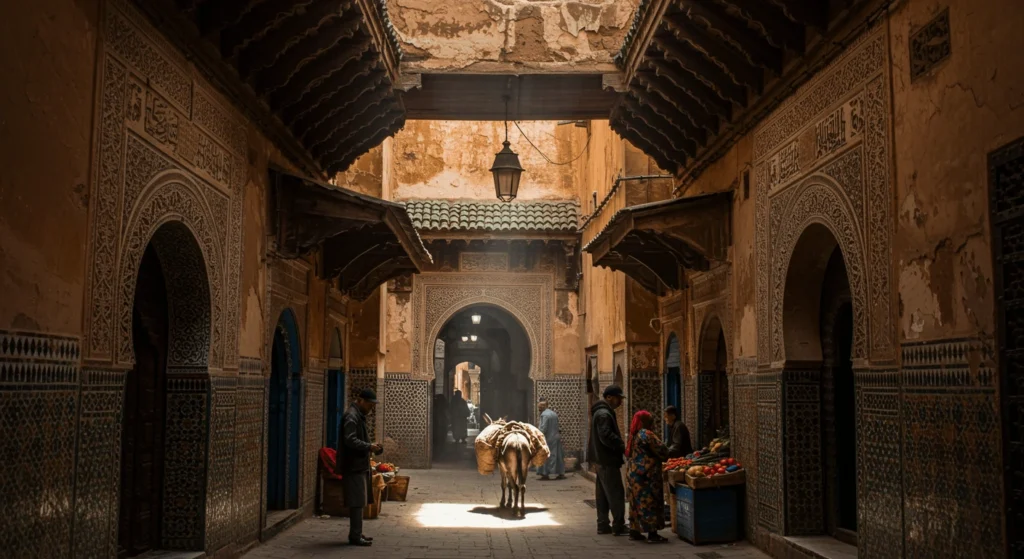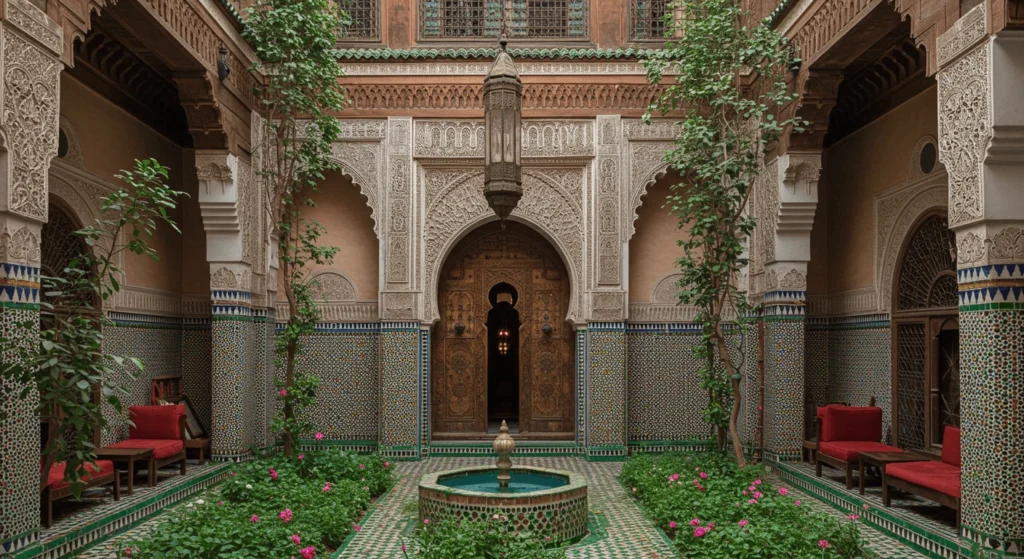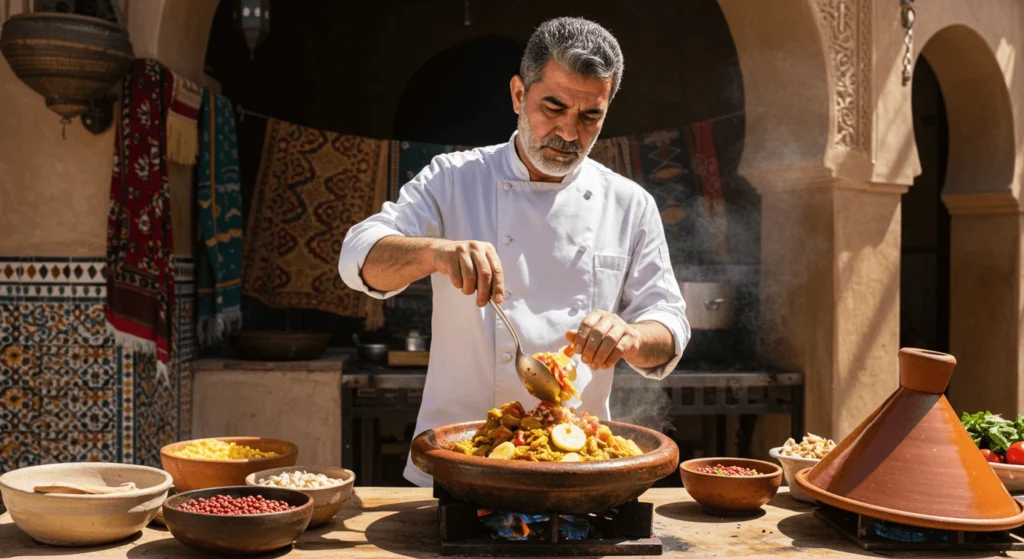Introduction
Where is Marrakesh? This vibrant Moroccan city, known as the “Red City,” lies at the heart of Morocco’s culture. Located between the Atlas Mountains and the Sahara Desert, Marrakesh blends history, tradition, and exotic charm. It is home to ancient medinas, bustling souks, and landmarks like the Koutoubia Mosque and Jemaa el-Fnaa square.
Marrakesh attracts travelers seeking adventure, cultural immersion, and breathtaking scenery. Visitors can explore the Medina’s maze-like streets or relax in traditional riads. The city is also a gateway to Morocco’s majestic landscapes, including the Atlas Mountains and the serene Agafay Desert.
In this blog, we’ll uncover Marrakesh’s location, cultural significance, and unique appeal. You’ll discover why this city is a must-visit for its history, architecture, and unforgettable experiences.
Where Is Marrakesh Located? A Guide to Its Geographic and Cultural Position

Marrakesh on the Map
Marrakesh, also known as the “Red City,” is located in central Morocco, offering travelers an ideal starting point for adventures. Specifically, it lies between the majestic Atlas Mountains to the north and the vast Sahara Desert to the south. Additionally, Marrakesh is approximately 240 kilometers southwest of Casablanca, one of Morocco’s busiest cities. Furthermore, it is 320 kilometers south of Rabat, the nation’s capital, and around 530 kilometers southwest of Fez, another historically significant city.
Moreover, Marrakesh is well-connected through its international airport, Marrakesh Menara Airport, which offers direct flights from Europe, Africa, and the Middle East. For those traveling within Morocco, the train from Casablanca takes less than four hours, while buses provide economical options for budget travelers. Therefore, its central location not only makes it easy to access but also positions it as a gateway to some of Morocco’s most iconic attractions.
Unique Geographic Context
Marrakesh’s geographic context is extraordinary because it combines contrasting terrains. To the north, the Atlas Mountains provide breathtaking views with snow-capped peaks during the cooler months. These mountains also serve as a popular destination for trekking and offer access to remote Berber villages, where traditional Moroccan life is still preserved. Furthermore, the Agafay Desert, located just south of the city, provides visitors with the chance to experience a stark, rocky landscape that differs from the golden dunes of the Sahara.
Historically, Marrakesh’s unique position made it a major trading hub. For instance, merchants traveling from Africa, Europe, and the Middle East passed through Marrakesh, bringing goods such as spices, gold, and textiles. Today, the city’s bustling souks still reflect its historic role in global trade. Consequently, Marrakesh continues to thrive as both a cultural and economic center, linking its past to its present.
Cultural Significance of Marrakesh
Marrakesh’s rich culture is deeply rooted in its history, shaped by Berber, Arab, and French influences. Founded in the 11th century by the Almoravid dynasty, it quickly became a political and cultural powerhouse. For example, the Medina, now a UNESCO World Heritage Site, showcases centuries-old streets, traditional riads, and architectural wonders. Additionally, landmarks like the Koutoubia Mosque and the Bahia Palace reflect the city’s Islamic and artistic heritage.
Moreover, Marrakesh’s culture is not only visible in its buildings but also in its vibrant daily life. Visitors can explore Jemaa el-Fnaa square, where street performers, food vendors, and artisans come together in a lively display of Moroccan traditions. Similarly, the city plays a central role in Morocco’s tourism, hosting international events such as the Marrakesh International Film Festival. As a result, it continues to draw global attention and solidify its status as the heart of Moroccan culture.
Why Marrakesh Is Known as the Heart of Morocco

A City Steeped in History
Marrakesh’s history stretches back over 1,000 years, making it a city rich in heritage and cultural significance. At its core lies the Medina, a UNESCO World Heritage Site, famed for its labyrinthine streets and traditional architecture. Walking through the Medina, visitors encounter vibrant souks, historic riads, and hidden courtyards, all reflecting Marrakesh’s storied past.
One of the city’s most iconic landmarks is the Koutoubia Mosque, built in the 12th century during the Almohad dynasty. Its towering minaret, visible from nearly every corner of Marrakesh, symbolizes Islamic architecture at its finest. Nearby, the Saadian Tombs, rediscovered in 1917, provide a glimpse into the grandeur of the Saadian dynasty, with intricate tilework and carved cedarwood ceilings.
Moreover, the Medina serves as a living museum, showcasing how ancient traditions have persisted alongside modern influences. Tour guides often share captivating stories about the city’s role in Moroccan history, further enriching the experience for visitors.
Vibrant Local Life
Marrakesh is synonymous with energy, excitement, and cultural vibrancy, all epitomized in Jemaa el-Fnaa square. This central hub comes alive every evening, transforming into a lively marketplace filled with food stalls, storytellers, and musicians. Visitors can savor traditional Moroccan dishes, such as grilled kebabs, harira soup, or msemen (Moroccan pancakes), while watching street performers entertain crowds.
The souks of Marrakesh, located within the Medina, offer a sensory overload of sights, sounds, and smells. Shoppers can browse stalls brimming with colorful spices, handwoven textiles, and intricately designed lanterns. Leather goods and argan oil are especially popular purchases, reflecting the city’s artisanal traditions.
Additionally, Marrakesh’s locals play a significant role in maintaining its authenticity. From artisans crafting goods by hand to shopkeepers sharing cultural insights, these interactions create a memorable connection for visitors. By engaging with the community, tourists gain a deeper appreciation of Marrakesh’s living traditions.
Architectural Beauty
Marrakesh’s architecture is a testament to its rich history, blending Berber, Islamic, and Andalusian influences. Traditional riads, characterized by their serene inner courtyards and ornate tilework, offer visitors a tranquil retreat from the city’s bustling streets. Staying in a riad provides an immersive experience, with many serving traditional Moroccan breakfasts or offering hammam services.
Among Marrakesh’s architectural gems is the Bahia Palace, a 19th-century marvel built to showcase Moroccan craftsmanship. Its intricate mosaics, carved wooden ceilings, and lush gardens make it a must-see for visitors. Similarly, the Menara Gardens, dating back to the 12th century, provide a peaceful escape with their olive groves and reflective pools framed by the Atlas Mountains.
The city’s commitment to preserving its architectural heritage ensures that every corner offers a story. Whether it’s the ornate gates of the Medina or the delicate zellij tiles in a hidden courtyard, Marrakesh remains a visual masterpiece.
Top Attractions and Experiences in Marrakesh

Discover Iconic Landmarks
No visit to Marrakesh is complete without experiencing the lively Jemaa el-Fnaa square. By day, it serves as a bustling marketplace filled with vendors selling fresh produce, traditional crafts, and souvenirs. As the sun sets, the square transforms into a vibrant hub of street performances, food stalls, and cultural displays. You can enjoy snake charmers, henna artists, and storytellers while savoring authentic Moroccan dishes like harira soup and msemen pancakes.
Another must-visit is the Majorelle Garden, an oasis of calm amidst Marrakesh’s energy. Originally designed by French artist Jacques Majorelle, it was later restored by Yves Saint Laurent, whose museum now stands adjacent to the garden. The lush greenery, vibrant cobalt-blue buildings, and serene pathways make it a favorite for photographers and nature lovers alike.
Additionally, landmarks like the Koutoubia Mosque, with its towering minaret, and the Bahia Palace, known for its intricate mosaics, provide unforgettable glimpses into Marrakesh’s architectural grandeur.
Dive Into Moroccan Culture
Immersing yourself in Moroccan culture is an essential part of any trip to Marrakesh. Begin by visiting a traditional hammam, where locals unwind through a centuries-old cleansing ritual. Many riads and luxury hotels offer private hammams, providing a relaxing and authentic experience.
Another cultural highlight is enjoying Moroccan mint tea, often served with freshly baked pastries. Tea ceremonies are an integral part of Moroccan hospitality and provide an opportunity to connect with locals.
For a hands-on experience, consider taking a cooking class to master iconic Moroccan dishes like tagine and couscous. These classes often start with a visit to the local souks to purchase fresh ingredients, giving participants insight into Marrakesh’s vibrant food scene. By the end, you’ll not only have a delicious meal but also a deeper appreciation of Moroccan culinary traditions.
Adventures Beyond Marrakesh
Marrakesh is the perfect base for day trips that showcase Morocco’s stunning natural beauty. The Atlas Mountains, located just an hour away, offer breathtaking views, hiking opportunities, and a chance to visit Berber villages. These villages provide a glimpse into traditional Moroccan life, with mud-brick homes and welcoming locals.
For a desert adventure, head to the Agafay Desert. This rocky expanse, often called a “stone desert,” is ideal for camel rides, quad biking, or simply enjoying a sunset dinner under the stars. If you’re seeking coastal charm, Essaouira is a nearby town known for its windswept beaches, fresh seafood, and historic medina.
Nature enthusiasts should not miss the Ouzoud Waterfalls, located around 150 kilometers from Marrakesh. These stunning falls are surrounded by lush greenery and are home to friendly monkeys. Visitors can take a boat ride, hike along the trails, or enjoy a picnic while soaking in the scenery.
How to Travel to Marrakesh and When to Visit

Getting to Marrakesh
Marrakesh is well-connected to the world through Marrakesh Menara Airport, making it easy to reach by international flights. The airport serves numerous airlines, including Royal Air Maroc, Air France, and Ryanair, with direct routes from major cities such as Paris, Madrid, and London. Additionally, seasonal flights from the United States and other global destinations increase accessibility for tourists.
For travelers already in Morocco, reaching Marrakesh is simple and affordable. The Moroccan rail system, operated by ONCF, offers comfortable train services connecting Marrakesh to Casablanca, Rabat, and Fez. For example, the train journey from Casablanca takes about three hours, providing scenic views along the way. Alternatively, CTM and Supratours buses are reliable and budget-friendly options for those traveling from smaller towns or cities. Taxis and private car services are also available for greater convenience, especially for short distances.
If you prefer a road trip, Marrakesh is accessible via well-maintained highways. Renting a car offers flexibility and allows you to explore other destinations en route, such as Essaouira or the Atlas Mountains.
Best Time to Visit Marrakesh
Choosing the right time to visit Marrakesh is essential for an enjoyable experience. The ideal months are spring (March to May) and autumn (September to November), when temperatures are pleasant and the city comes alive with blooming flowers and festivals. During these seasons, daytime temperatures average around 20–25°C (68–77°F), making it comfortable to explore outdoor attractions like the Medina or the Majorelle Garden.
Summers in Marrakesh can be intense, with daytime temperatures often exceeding 40°C (104°F). However, this season is also less crowded, offering quieter streets and discounted accommodation rates. If visiting during the summer, plan activities in the early morning or late evening and stay hydrated.
Winter (December to February) is another favorable time, especially for travelers who prefer cooler weather. With daytime temperatures ranging from 12–20°C (54–68°F), winter provides a mild climate for sightseeing. Additionally, the snow-capped Atlas Mountains during this period create a picturesque backdrop for day trips.
Where to Stay in Marrakesh
Marrakesh offers a diverse range of accommodations to suit all preferences and budgets. For an authentic Moroccan experience, staying in a riad is highly recommended. These traditional houses, often located in the Medina, feature stunning courtyards, intricate tilework, and serene atmospheres. Many riads, such as Riad Be Marrakesh or Riad Yasmine, provide personalized service, traditional Moroccan breakfasts, and rooftop terraces with breathtaking views of the city.
For travelers seeking luxury, Marrakesh is home to world-class hotels and resorts. Properties like La Mamounia, Royal Mansour, and the Oberoi Marrakesh offer opulent rooms, fine dining, and spa facilities, creating a haven of relaxation amid the city’s vibrancy.
Budget-conscious travelers will also find plenty of options, including boutique hostels and affordable guesthouses. Hostels like Rodamon Riad provide a mix of comfort and style at a reasonable price, often featuring shared spaces that encourage social interaction.
When booking accommodations, consider their proximity to key attractions. Staying within the Medina offers convenient access to landmarks like Jemaa el-Fnaa and the souks. Alternatively, modern neighborhoods like Gueliz provide a quieter stay with easy access to restaurants and shopping.
Why Marrakesh Should Be on Your Travel Bucket List

A Unique Fusion of History and Adventure
Marrakesh is where history meets adventure, offering a rich blend of cultural experiences and thrilling outdoor activities. The city’s Medina, a UNESCO World Heritage Site, is a maze of ancient streets filled with souks, riads, and mosques that showcase its historical significance. Exploring this area feels like stepping back in time.
For those seeking adventure, Marrakesh serves as a gateway to the Atlas Mountains and the Agafay Desert. Camel rides at sunset provide an unforgettable experience, while guided treks in the mountains offer panoramic views of the region. Quad biking through the rocky landscapes of the Agafay Desert is another popular activity for adrenaline seekers. These adventures allow travelers to experience the diverse geography that surrounds the city.
Moreover, Marrakesh’s proximity to the Sahara Desert makes it an ideal starting point for multi-day excursions. Travelers can camp under star-studded skies, enjoy traditional Berber music, and immerse themselves in the serene beauty of the desert.
A Food Lover’s Paradise
Marrakesh is a dream destination for food enthusiasts, offering a mix of street food and upscale dining experiences. Start your culinary journey at Jemaa el-Fnaa square, where food stalls serve Moroccan classics like harira soup, grilled kebabs, and msemen pancakes. These dishes are prepared fresh and provide a true taste of Moroccan street food.
For a more immersive experience, visit local markets such as Souk Semmarine, where vendors sell fresh produce, vibrant spices, and artisanal products. Sampling olives, dates, and preserved lemons gives insight into the flavors that define Moroccan cuisine. The spices, including saffron, cumin, and paprika, are not only aromatic but also integral to traditional recipes.
For fine dining, Marrakesh boasts exceptional restaurants like Dar Moha and Al Fassia, which offer gourmet interpretations of Moroccan dishes. Many of these establishments are located in beautifully restored riads, providing an elegant atmosphere alongside flavorful meals. Cooking classes are also available, giving visitors the chance to learn how to prepare dishes like tagine and pastilla, combining education with indulgence.
Marrakesh’s Timeless Appeal
Marrakesh’s charm lies in its ability to seamlessly blend ancient traditions with modern comforts. Staying in a riad allows travelers to experience Moroccan heritage while enjoying modern amenities. These intricately designed homes offer a peaceful retreat with features like mosaic fountains and rooftop terraces overlooking the Medina.
Photographers and social media enthusiasts are drawn to Marrakesh’s photogenic sites, from the cobalt-blue Majorelle Garden to the ornate Bahia Palace. The warm tones of the city’s architecture, paired with the bustling life of its streets, create a visual feast.
Additionally, Marrakesh’s people are known for their hospitality. Locals often welcome visitors with mint tea, a symbol of Moroccan generosity. Engaging with artisans, shopkeepers, and guides provides meaningful connections and enhances the travel experience.
The city’s timeless allure has also made it a favorite among celebrities and influencers. With its unique blend of history, culture, and elegance, Marrakesh remains an iconic destination that captivates visitors from around the globe.
Conclusion
Marrakesh is a city that effortlessly captures the essence of Morocco’s rich heritage, diverse landscapes, and vibrant culture. Its geographic location, nestled between the towering Atlas Mountains and the sweeping Sahara Desert, makes it a gateway to thrilling adventures and natural wonders. From the historic Medina, a UNESCO World Heritage Site, to its lively souks and stunning architectural landmarks, Marrakesh offers an unmatched blend of history, culture, and modernity.
Known as the “heart of exotic Moroccan adventures,” Marrakesh provides experiences for every kind of traveler. Whether exploring the bustling Jemaa el-Fnaa square, indulging in Moroccan cuisine, or embarking on camel rides through the Agafay Desert, visitors will find countless ways to immerse themselves in its charm. The city’s timeless appeal lies not only in its photogenic sites but also in the warmth and hospitality of its people.
Now is the perfect time to start planning your journey to Marrakesh. Begin by exploring its historic streets, sampling its incredible food, and discovering its breathtaking scenery. Experience the magic of Morocco in a city where ancient traditions meet modern comforts.
So, pack your bags, prepare for adventure, and let Marrakesh enchant you with its beauty, culture, and unforgettable experiences. Start planning your journey today and create memories that will last a lifetime!

